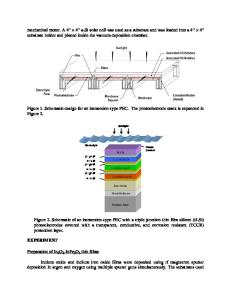Shape-Controllable Synthesis of Indium Oxide Structures: Nanopyramids and Nanorods
- PDF / 325,891 Bytes
- 6 Pages / 612 x 792 pts (letter) Page_size
- 80 Downloads / 336 Views
Cheoljin Lee Department of Nanotechnology, Hanyang University, Seoul 133-791, Korea (Received 10 July 2003; accepted 3 September 2003)
We describe a vapor-phase route to the controllable synthesis of indium oxide microand nanopyramids on the silicon wafer via selective epitaxial vapor-solid growth by a methane-assist thermal reduction method. X-ray diffraction, scanning electron microscopy, and transmission electron microscopy revealed that the pyramids were cubic single crystals with a tetragonal symmetry. The size, morphology, and density of pyramids could easily be controlled by tuning reaction parameters. The method has good compatibility with other procedures involved in the microfabrication processes. Laterally grown indium oxide nanorods on the silicon wafer were also prepared via a vapor-liquid-solid mechanism. Those crystalline In2O3 nanorods were about 100 nm in diameter and 1 m in length. The as-synthesized indium oxide nanopyramids and nanorods could offer novel opportunities for both fundamental research and technological applications.
I. INTRODUCTION
The preparation and physical property investigation of indium oxide have drawn much attention due to its remarkable performance on low electrical resistivity (Sn-doped indium oxide), high visible-light transparency (∼90%), and high infrared reflectivity.1,2 In2O3 is a versatile wide-band-gap semiconductor (direct band gap: ∼3.6 eV)1 and has widely been used as antireflection (AR)coatings and transparent electrodes in solar cells,2 transparent electrodes in flat panel displays and organic light-emitting diodes,2,3 gas sensors,4 window heaters,5 varistors,6 and so forth. Various well-established techniques, such as vacuum evaporation,7 pulsed laser ablation,8 magnetron sputtering,9 electrochemical deposition,10 sol-gel,11 and spray pyrolysis12 have been used to prepare In2O3 or Sn-doped indium oxide with different structures (including films, nanobelts, nanowhiskers, and particles).7–13 However, most of them are amorphous or polycrystalline solids. It is also of interest to grow singlecrystalline In2O3 or Sn-doped indium oxide with controllable size, structure, and morphologies because of fundamental scientific research interests as well as for practical reasons. Here we report that indium oxide can be made into a tetragonal pyramid-shaped or so-named
prism-shaped morphology. The synthesized In2O3 pyramids possess a single-crystalline structure with controllable size in mesoscale range and extremely smooth facets. To the best of our knowledge, this is the first time indium oxide with such unusual tip-shaped structure was prepared. Moreover, these peculiar crystallographically well-defined In2O3 pyramids can strongly affect intrinsic physical properties of material and offer exciting opportunities for vacuum microelectronic and optoelectronic applications. One of the potential applications of the In2O3 pyramids is to be used as cold-cathode field emitters. The small radius of curvature at their tip is expected to lead to an increase of field enhancement f
Data Loading...











